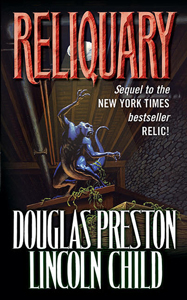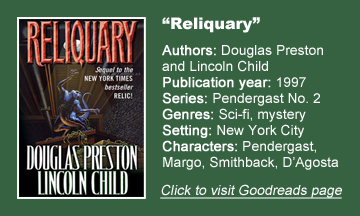“Reliquary” (1997) is the second Pendergast novel from Douglas Preston and Lincoln Child, and even though he again doesn’t show up until quite a ways into the book, the FBI agent plays a more central role than in “Relic.”
It’s also the second New York Museum of Natural History novel, but while it does include some scenes in the grand building and features employees Margo Green and Dr. Frock, this sequel gets out into the city – and beneath it.
Beneath these streets
In a striking statement, Pendergast notes that the tunnels beneath NYC are the most unknown, least-mapped portion of the Earth. Preston and Child explain further in their authors’ note:
It has been estimated that as many as 5,000 homeless people have lived in the vast warren of underground tracks, subway tunnels, ancient aqueducts, coal tunnels, old sewers, abandoned stations and waiting rooms, disused gas mains, old machine rooms, and other spaces that riddle underground Manhattan.
The authors fib some details – after all, many details are unknown — but they get into the general spirit of underground exploration. Most striking are the Astor Tunnels, constructed in the 19th century for the city’s elite to comfortably travel in and out of the city by subway.
They took the elevator down the equivalent of 30 stories below the surface and could wait in an opulent lounge area with a huge chandelier and tile-and-mirrored walls.
But this isn’t like the Teenage Mutant Ninja Turtles’ luxurious abandoned subway lair in “TMNT III.” There’s no hominess to any of these places, even though Mephisto – the “mayor” of the community below Central Park – speaks up for this way of living.
By the novel’s 1997, those Astor Tunnels – unvisited even by Mephisto’s group — have become “the Devil’s Attic,” long since flooded, destroyed and darkened, making for a foreboding piece of urban archaeology.
Focus on core characters
Of all the fascinating corners of the globe P&C have since brought us to, this still might be the best. But the final act is more overblown than that of “Relic,” and our heroes’ logistical confusion when moving through those tunnels translates to a reader – not always in a good way.
Bombs are set and encounters with the Wrinklers take place, and I didn’t get a good sense of how long until the charges will go off or what the escape path is.
But before that, “Reliquary” is as gripping as its predecessor, and it’s tighter because we zero in on Margo, Pendergast, D’Agosta and Smithback. There are additional characters, including cop Laura Heyward – one of the foremost experts on the underground homeless and a future P&C regular – but not the dozens upon dozens found in “Relic.”
The back-of-the-napkin description is that “Reliquary” is the “Aliens” to “Relic’s” “Alien.” The authors gave us a teaser at the end of “Relic” showing museum scientist Gregory Kawakita going into the drug trade, growing the plant fibers the Museum Beast lived on.

Kawakita’s disappearance is the first of many little mysteries surrounding the rise of the mysterious Wrinklers, who homeless people say live in the Devil’s Attic.
Not a ‘Relic’ repeat
P&C rather cleverly craft “Reliquary” so we’re regularly thinking of “Relic’s” threads, yet it’s a continuation rather than a repeat. People smell that same “goatish odor” before being attacked. But it’s almost creepier to think the Wrinklers are less far removed from humanity than Mbwun was.
Pendergast and D’Agosta move closer to vintage form here as P&C become more confident writing about them. The FBI agent embarks on an investigation of the tunnels and fits all kinds of supplies in the lining of his trenchcoat.
The lieutenant swears and fondles his cigar, chafing at the increasing number of “no smoking” signs. Pendergast unhesitatingly eats a rat to fit in on an undercover mission, and we’re treated to D’Agosta’s reactions.
Aside from the person eventually revealed as the central villain, Margo has the closest to a character arc, as she looks to empower herself after her brush with death in “Relic.” She works out and takes shooting lessons, and gets TO’d whenever the boys try to prevent her from going with them on a mission.
In a line that made me laugh, she tells Pendergast he’d be “Mbwun droppings” if not for her help. Margo is the heart of the book because she drives the small pseudo-science mysteries (with potentially big repercussions) that drive “Reliquary” just as they did “Relic.”
Fascinating urban mess
It’s fun to see journalist Smithback drool over his latest book deal, which entails following around the rich and well-spoken Mrs. Wisher, who leads Take Back Our City marches after the murder of her daughter. (I’m not sure this would’ve been such a hot seller on the face of it, but after his adventure, he has plenty to write about.)
We’re introduced to P&C’s “big” type of writing – with a dark-comedy bent — when herds of protestors meet up with herds of homeless who are forced out of their tunnels by the police.
The authors don’t get starkly political, but the novel does ultimately paint a picture of a New York City that has been built up through the years by shoddy planning, failed projects, bureaucratic incompetence and corruption.
At the same time, their NYC is evocative and it’s clear the authors love the city, finding some beauty at least in the aboveground parts. Belowground, we’ll have to settle for creepy fascination.


